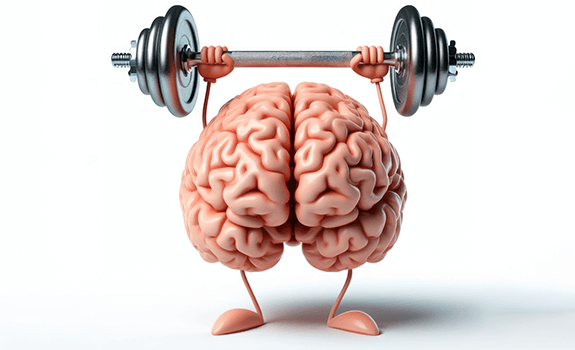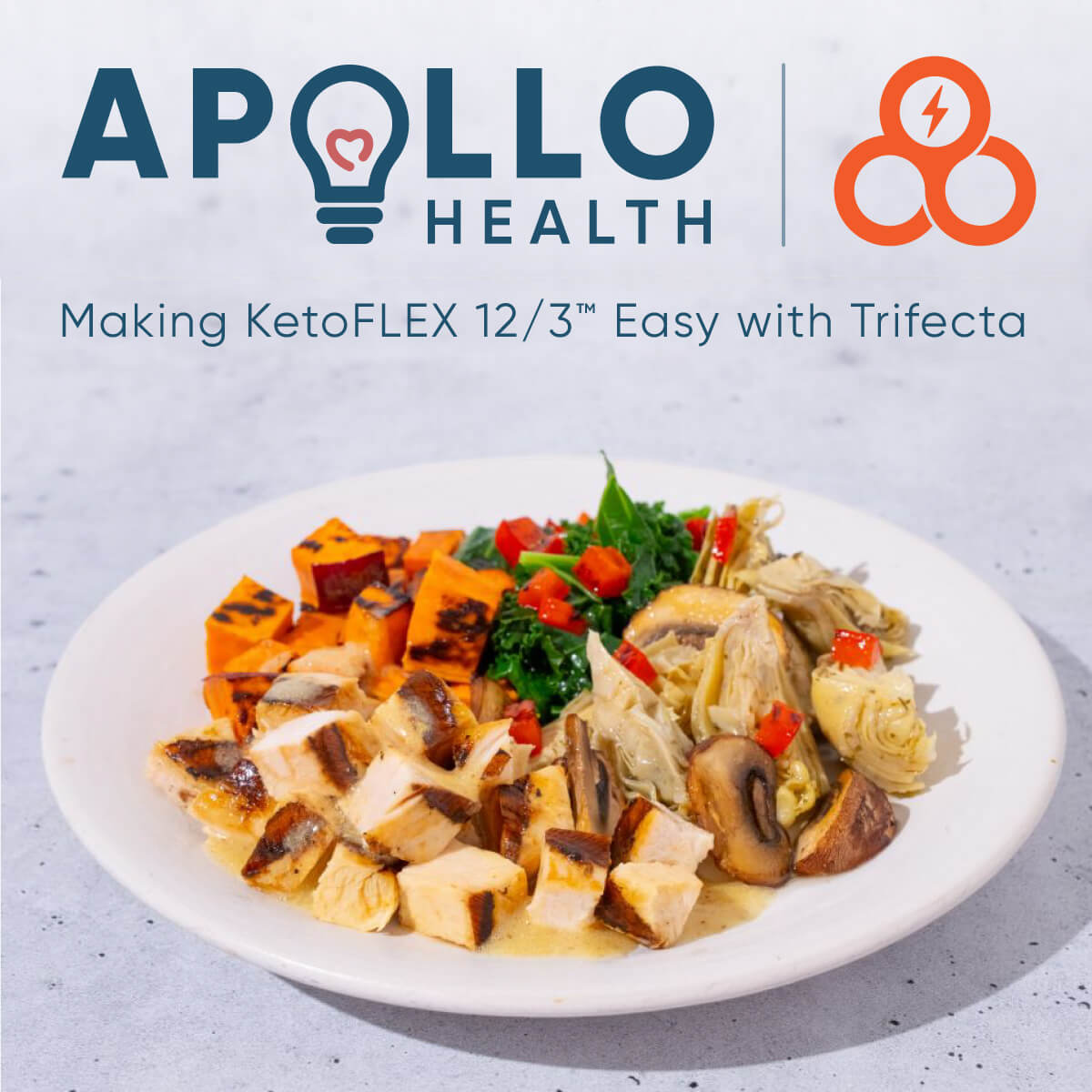June 14, 2024
Brains and BRAWN for Brain Health

By Julie Gregory, Chief Health Liaison for Apollo Health
If you think you have to choose between healthy cognition or strong muscles while practicing the Bredesen Protocol, nothing could be further from the truth. Research shows that strong muscles protect against dementia. Even better, improving muscle strength has been shown to improve multiple cognitive domains, including memory and executive function. Strength training increases brain volume, strengthens our bones, and helps protect against white matter lesions. An added benefit of building and maintaining muscle mass is the effect on metabolism. Strong muscles burn more calories and protect against insulin resistance, thereby improving how fuel is supplied to the brain. Staying strong also helps us maintain independence, breeze through activities of daily living, and enables us to actively enjoy our golden years.
The bad news is that sarcopenia (the loss of lean muscle mass) is epidemic among older people. Muscle loss begins in our 30s, becomes rampant in our 50s, and can become even more aggressive into our 60s, 70s, and beyond. Studies show that this does not have to be the case. We can intervene (even if we’ve never engaged in strength training before) and build muscle into our 90s. The stumbling block for most people is that it becomes a whole lot harder to get benefits from strength training as we age. The same amount of effort that we may have put into our strength training routine in our 30s will not yield the same result. Read on for tips and tricks to help you build muscle and stay strong as you age.
Use it or lose it: It’s true, especially as we age — our muscles will progressively weaken if we don’t challenge them regularly. Simply moving more and engaging in a daily minimum 30-minute aerobic activity (as simple as walking outdoors in nature) is an important part of the protocol and a great start towards building muscle strength. However, it’s just the beginning. Adding on a strength training regimen is key.
If you’ve never formally engaged in strength training, you may want to consider joining a local gym, YMCA, senior or community center. In addition to offering the equipment that you’ll need, many provide trainers who can help you develop a personalized program to meet your goals. People at all fitness levels can engage in strength training. It’s important to start slowly and incrementally increase weight as you are ready.
Strength training is also referred to as resistance training, as you can use your own body weight, free weights, machines, or bands to provide resistance to strengthen your muscles. The basic idea is to isolate specific muscles (and muscle groups) so that you can strengthen each with specific exercises. Every exercise will provide an opportunity for tension and relaxation.
For example, to isolate the biceps (a major muscle in your upper arm), consider bicep curls. Choose a weight that mildly challenges you. To begin, stand with your feet shoulder-width apart and keep your abdomen engaged. For curls, you tense (squeeze) the bicep as the weight comes up and slowly relax (release) it as the weight goes down.

Exercises are typically split into “reps,” the number of exercises that you’ll perform in each “set,” which is the number of cycles of reps that you complete. A typical routine may include ten reps divided into three sets. Your biceps should feel challenged but not fully exhausted after three sets. Adjust your chosen weight as needed.
Many people develop split routines in which they train different body parts on different days to give the just-exercised muscles a chance to heal and grow stronger. Indeed, that is how muscles become stronger. Strength training creates micro tears that repair during rest and ultimately strengthen the muscle. A typical routine may include your chest, back, and abdomen on one day and your arms (biceps, triceps) and legs (quadriceps and calves) on the alternate day.
Feed your muscles: After challenging your muscles, it’s important to provide all of the building blocks needed for repair to help rebuild and strengthen them. Protein is a key macronutrient for muscle growth. Many other health experts recommend high amounts of protein for muscle growth and maintenance, especially as we age. The problem is that high amounts of animal protein can be pro-inflammatory and accelerate aging, which can ultimately harm overall health and cognition. These same experts ignore the vital role of GI health for optimal protein absorption.
Instead of pushing enormous amounts of protein, The KetoFLEX 12/3 dietary plan encourages an ADEQUATE amount of high-quality clean protein, preferably from both animal and plant sources, to optimize vital macro and micronutrients to support muscle strength and cognition, along with a heavy focus on optimizing gut health to aid in optimal protein absorption.
The actual protein needs for each person are highly individualized. For healthy people under age 65, your goal is to target and not exceed 0.8 to 1.0 grams of animal protein per kilogram of lean body weight per day. You can use your hand to help you visualize this amount, which equates to about two palm-sized pieces of clean animal protein. For example, two eggs could represent one palm, and 4 to 6 oz of sockeye salmon could represent another. Indeed, our top protein picks for brain health are pastured eggs and low mercury, wild-caught seafood because of the neuroprotective qualities of their unique fat. The choline from egg yolks and omega-3 fatty acids (especially DHA) from seafood are critical for raw synaptic support. Pastured poultry and grass-fed meat (including small amounts of organ meats) are other acceptable animal protein sources.
Depending upon your starting place, you may initially need more protein as you work to heal underlying damage, transitioning to less as you heal. It’s important to identify your personalized protein needs by being aware that specific groups of people may need more protein.
● Those with chronic GI issues, including GERD (especially those using PPIs and other antacids), SIBO, IBS, etc.
● Those diagnosed with Type 3 (Toxic) Alzheimer’s
● Those with underlying illness, active infections, and recovering from surgery
● Those over age 65, especially those with marked muscle loss
● Those with suboptimal BMIs (below 18.5 for women and 19.0 for men.)
● Those who engage in rigorous sports or physically demanding work
Be aware that not everyone who falls into these categories automatically needs more animal protein. This is especially true for those who are healthy, have optimized GI digestion (especially adequate stomach acid), and are actively encouraging muscle growth through daily challenging movement. If you fall into one or more of the bulleted categories above, increase your animal protein intake to 1.1 to 1.2 grams per kilogram of lean body weight per day until you can address the specific root cause of whatever is causing you to have an increased need for or insufficient absorption of protein with the ultimate goal of working towards our recommended amount.
The timing of your protein intake can also play a part in protecting your muscle mass. Recent research suggests that getting around 30 grams of protein (preferably from animal sources) within one to two hours post-exercise can help stimulate muscle building. If you exercise later in the day, be mindful to refrain from eating a minimum of three hours before bed so as not to interfere with the promotion of autophagy. See Cognitive Restoration Through Fasting to learn more.
Our protein goal/limit only refers to animal protein. Ideally, you should concurrently consume an abundance of protein from plants. All plants have some amount of protein, but most of the protein from plants is incomplete (lacking all nine essential amino acids), and the fiber and antinutrients deter absorption. There is no need to limit your protein from plants when used as a whole food. We encourage 6 to 9 cups of non-starchy vegetables per day, preferably local, organic, and seasonal, from every color of the rainbow. See Not Your Daddy’s Keto to learn much more about KetoFLEX 12/3. If you prefer to use a vegetarian or vegan approach, please heed the warnings in KetoFLEX 12/3 for Vegans and Vegetarians.
Consider supplements: Supplements are supplemental, and that holds true when trying to build and maintain muscle. Focusing on the basics: strength training, GI optimization, and adequate protein intake, on the backbone of the Bredesen Seven (the foundational strategies used to create neuroplasticity) should be primary. However, specific supplements and hormones can sometimes help to enhance muscle building and maintenance, especially as we age. These should be used under the care of a ReCODE physician, who can safely help you personalize the recommendations in your PreCODE or ReCODE Report.
Creatine: Creatine is a combination of three amino acids that are produced naturally in your body. It can be found in your muscles and brain where it helps to provide energy. Creatine stores decline with age, supporting the need for creatine as a dietary supplement, which has been shown to promote muscle gains and improve cognition. Please consult with your physician to see if creatine may be appropriate for you.
Creatine monohydrate is a tasteless powder that you can add to clean filtered water. Research suggests consuming it in the morning, post-workout provides the most benefit.
DHEA Sulfate: Dehydroepiandrosterone (DHEA) is a hormone produced by the body’s adrenal glands. The body uses DHEA to make androgens and estrogens, the male and female sex hormones. DHEA levels peak at about age 25, then go down steadily as you age. DHEA is the precursor to testosterone, which is vital for muscle strength. For men, optimal levels are 150 to 500 mcg/dl; for women, optimal levels are 100 to 380 mcg/dl. Keep in mind that levels tend to decrease with age. If your levels are lower than the listed target range, it may be helpful to optimize with supplementation to support muscle health as well as to provide adequate trophic support for cognition. It’s important to test your blood levels before supplementing. If you’ve completed the Apollo Health blood labs, your PreCODE or ReCODE Report will provide this information as well as supplement recommendations. Please work with your ReCODE physician for additional guidance on personalizing your supplements. Anyone with a current or historical hormonally-driven cancer should avoid this supplement.
Testosterone: This is a hormone that is produced primarily in the testes for men and in the ovaries and adrenal glands for women. It is integral for building muscle mass and strong bones. Low levels of testosterone are also associated with brain fog and poorer cognition. Women have much less testosterone than men, but it’s vital for both sexes. Testosterone begins to drop by age thirty. Sometimes, optimizing DHEA will help to bring testosterone to a healthy level. If not, you may want to consider working with your ReCODE physician to supplement testosterone directly. As with DHEA, anyone with a current or historical hormonally-driven cancer should avoid this supplement.
| TESTOSTERONE GOAL | Men’s Range | Women’s Range |
|---|---|---|
| Free Testosterone (serum) | 65 – 150 pg/ml | 0.2 – 5 pg/ml |
| Total Testosterone (serum) | 500 – 1000 ng/dl | 25 – 60 ng/dl |
If you’ve completed the Apollo Health blood labs, your testosterone results and dosing recommendations will be shared in your PreCODE or ReCODE Report, which is reported as both free testosterone and total testosterone. For both DHEA and testosterone, you should be targeting a physiological level (using our goals) that is appropriate to your body’s healthy or normal functioning, bearing in mind that levels naturally drop with age. Testosterone requires a prescription that your ReCODE physician can oversee.





